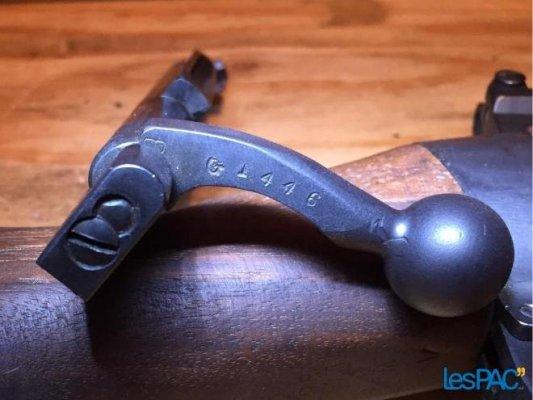-
Legacy Member

Dampherb,
The large "B" stamped into the root of the bolt handle, as in your photo:

---is a BSA maker's mark from their early production of the No 4 rifle.
So, that and the matching serial number indicate you've got the rifle's original bolt.
-----krinko
-
-
10-23-2016 04:46 PM
# ADS
Friends and Sponsors

-
Legacy Member

Did they use bolts with the hollow bolt knob on No.4 rifles when originally made or just the No.5? Just a question so I'll know what I'm looking at when I come across something I might be interested in. I figure they probably used either one on a rebuild.
-
-
-
The bolts were all interchangeable in theory and in world wide practice. It made absolutely no difference to Armourers. Indeed, later the supposedly different parts, such as lightweight trigger guards and sears all morphed into a unified single number.
-
Thank You to Peter Laidler For This Useful Post:
-
Legacy Member

Thanks, I just wasn't sure if they made the hollow ones before they designed the No.5 rifle.
-
-
FREE MEMBER
NO Posting or PM's Allowed

So its probably have been rebuilt from unknown parts and made by BSA even though the owner claim its an original Maltby.
But what does the ''G'' in the serial number mean ?
Do you think its a great purchase for hunting and fun shooting or it might be a risk considering I don't know where the other parts came from ?
And if it is a BSA rifle, why does the serial start with a 1 ?
Last edited by Dampherb; 10-24-2016 at 02:17 PM.
-
Legacy Member

It depends on what you are looking for as to whether or not not you should consider this rifle. If you are looking for a "highly original collectors piece" this item is probably not for you. As I've already stated as far as I'm aware all British produced No4s had a paint finish but some/all Canadian
produced No4s had a paint finish but some/all Canadian produced examples were blued. I stand to be corrected on this, as previously stated, and I'm not sure what finish U.S. Savage examples had.
produced examples were blued. I stand to be corrected on this, as previously stated, and I'm not sure what finish U.S. Savage examples had.
-
-
Advisory Panel



Originally Posted by
Dampherb

But what does the ''G'' in the serial number mean ?
It means this serial range comes after the series that starts with "F".
-
Thank You to browningautorifle For This Useful Post:
-
Advisory Panel


It's been cleaned up: polished buttplate and screws, no dirt around the butt socket, very crisp edges to the forend at the butt end. Probably a sporterized rifle that has been restored. The handguard edges do not appear to match the forend profile well, they also look more worn. Yes, that is sometimes seen on unaltered rifles, especially ex-Indian ones, but here it says something else, to me anyway. The finish on the metal is probably original from what I can see.
Now, when does the bad English start? 
“There are invisible rulers who control the destinies of millions. It is not generally realized to what extent the words and actions of our most influential public men are dictated by shrewd persons operating behind the scenes.”
Edward Bernays, 1928
Much changes, much remains the same. 
-
-
Legacy Member

"And if it is a BSA rifle, why does the serial start with a 1 ?"
BSA did not start using the regular number pattern, as in "A 35620" until sometime in 1944, or maybe later 1943. Up until then, the serial numbers ran through the single letter prefixes and into double letter prefixes. My 1941 BSA is "A2111" for instance.
"...as far as I'm aware all British produced No4s had a paint finish..."
produced No4s had a paint finish..."
As far as WW2 British No4 rifles are concerned, my 1941 BSA is blued, 1944 BSAs were still being blued and so were my 1943 Fazakerleys. I never got onto a Maltby that wasn't altered post war, so I don't know there.
Savage rifles were Dulite blued, just like Long Branch rifles.
-----krinko
-
-
Legacy Member

-















 PM
PM














